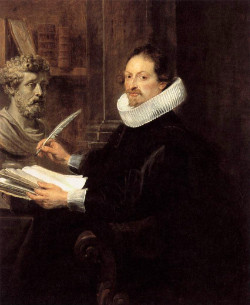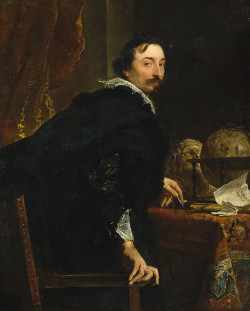A Lady Writing
c. 1662–1667Oil on canvas
45 x 39.9 cm. (17 3/4 x 15 3/4 in.)
National Gallery of Art, Washington D.C.
A woman viewed three-quarter-length is seated at a desk in a shadowed interior writing a letter. She wears a luxurious yellow jacket trimmed with spotted white fur, pearl earrings, and yellow and white ribbons in her hair. The soft light falling from the upper left illuminates her with a smoky cast. In her right hand she holds a quill pen that is still applied to the paper, while she rests her other hand on the tablecloth.
other arm on the table, as if she had only just been diverted from her writing. The elegant author turns her attention from the letter that she writes and looks out momentarily at the viewer. A hint of a smile crosses her lips (fig. 1). She sits in a straight-backed chair with leather upholstery and lion's-head finials. The table covered with a slate blue cloth has rare objects on it: a small silver-studded wood box, a silver inkwell, and a string of pearls extended horizontally across the table with a yellow silk ribbon. On the plaster wall in the distance is a barely discernible painting in an ebony frame depicting a still life, which included a foreshortened bass viola.
The care with which the design is composed is again revealed in its geometry; the width of the expanse of plaster wall at the right is equal to the height of the table, which in turn is half the distance from the bottom of the painting to the lower edge of the ebony frame of the picture at the back. The woman in the present work has more individualized features than some of Vermeer's models, and it has sometimes been speculated that she could portray the artist's, wife, Catharina Bolnes, who, having been born in 1631, would have been an appropriate age (early to mid- thirties) if this work was painted as customarily dated in the mid-1660s. However, with no surviving image of Catharina, there is no proof.

Johannes Vermeer
c. 1662–1667
Oil on canvas, 45 x 39.9 cm.
National Gallery of Art, Washington D.C.
The subject of a woman writing a letter was also addressed by Vermeer in his painting Lady Writing a Letter with Her Maidservant in Dublin that is included in this exhibition. Among the six paintings in the painter's small oeuvre that deal with letter themes, all depict women, but most are represented reading. The seated lady in Mistress and Maid in the Frick Collection, New York, had evidently been writing a letter before she unexpectedly receives a letter delivered by the maid. Those two paintings differ from the present work in depicting the lady accompanied by a maidservant who in one case awaits her reply and in the other delivers the missive. The subject of a woman writing a letter had been first popularized by Gerrit ter Borch in his famous painting now in the Mauritshuis (fig. 2); however, Ter Borch and the other artists who he influenced never depicted the woman looking out directly at the viewer. Only Gabriel Metsu represents the woman looking at us as she writes (fig. 3), and in that case he was probably influenced by the present work. Vermeer's lady in yellow engages our gaze, seemingly acknowledging the observer without alarm or surprise, but with a disarming candor, even familiarity. Indeed, among Vermeer's full and knee-length genre paintings (as opposed to bust and head-length or portrait studies), the genial lady in the Washington painting is one of only three (see also Woman Standing at a Virginal and the Woman Seated at a Virginal, both in the National Gallery, London, who looks directly out at the viewer.

Gerrit ter Borch
c. 1665
Oil on canvas, 39 x 29.5 cm.
Mauritshuis,The Hague

Gabriel Metsu
c. 1665
Oil on canvas, 39.4 x 31.1 cm.
Private collection
The woman wears the same fur-trimmed yellow jacket that appears in several other works by the artist that are also usually dated to the mid-1660s or later; see, as examples, Woman with a Lute in the Metropolitan Museum of Art, New York, Woman with a Pearl Necklace in the Gemäldegalerie, Staatliche Museen zu Berlin, The Guitar Player, Kenwood House, London, Iveagh Bequest, The Love Letter in the Rijksmuseum and, again, Mistress and Maid in the Frick Collection. In all probability this garment is identical with the "yellow satin mantel with white fur trimming" listed in the inventory of Vermeer's household effects drawn up after his death in 1676. The small ebony box with studded decorations and the inkwell also appear in his other genre paintings, suggesting that Vermeer, like Ter Borch and so many other artists of the period, confected his genre scenes not only from a standard series of settings but also with a repertoire of costumes and props that he probably retained in his own possessions.
The painting in the background may also be one that he owned. Other paintings in the backgrounds of Vermeer's paintings seemed to have been in the family collection (for example, Dirck Baburen's so-called Procuress (Museum of Fine Arts, Boston) appears in two of his own pictures and corresponds to a painting of a koppelarster mentioned in the inventory, although it typically was simply listed, without any attempt to divine the author. Among the paintings in the 1676 inventory was an unattributed painting depicting "a bass viol with a skull." There is no skull visible in the painting within the present painting, but that area of the picture is sunken and the original design is scarcely discernible today. still life paintings of bass viols were produced in Holland but, unlike in Flanders or Italy, were uncommon, especially featuring skulls. Moreover, Dutch genre paintings like the present one in which a person featured prominently acknowledges the viewer often carried a pointed moral message.
Consider the example of the central woman holding a letter as she brazenly fixes our gaze in Hendick Pot's Allegory of Vanity (fig. 4), while an old woman openly brandishes a skull behind her. The musical instruments in the painting-within-the-painting in the present work could of course allude to the young lady's musical talents and charms. But the fact that she engages us so directly begs the question of whether the painting in the background was once centrally significant, since in both pictures in the National Gallery a pointed gaze was coupled with paintings-within-paintings that have been regarded as central to Vermeer's meanings.
 fig. 4
Allegory of Vanity
fig. 4
Allegory of VanityHendrik Gerritsz Pot
1630–1635
Oil on panel, 58 x 73 cm.
Frans Halsmuseum, Haarlem
This delightfully engaging picture is probably identical with lot 35 in the Dissius sale of 1696: "Een Schryvende Juffrouw heel goet van denzelven [Vermeer] (A Young Woman Writing very good by the same). Jacob Dissiu's father-in-law, Pieter van Ruijven, acquired comparable paintings by Vermeer such as the Woman with a Pearl Necklace and Woman with a Balance, and there can be little doubt that he also purchased A Lady Writing directly from the artist.
Unless one sees the canvas in Washington frequently it might easily be imagined as larger than it is. The intimate Woman in Blue Reading a Letter and the Girl with a Pearl Earring are almost identical in size. However, the design of the present picture—with a broad base established by the table and chair, the pyramidal figure (with the woman's face centred between the lateral sides of the composition), and the simple background which reinforces the overall impression of order and poise—lends the work an imposing quality, like that often found in formal portraiture. It appears probable that Vermeer, with his gift for creative synthesis, saw that a newly fashionable type of genre picture, which was evidently introduced by Gerard ter Borch (fig. 20a), could be modified expressively by adopting an arrangement familiar from Dutch and Flemish "scholar portraits," such as Rubens's Caspar Gevartius (fig. 5) (Koninklijk Museum voor Schone Kunsten, Antwerp), Van Dyck's Lucas van Ujfel (fig. 6) (Metropolitan Museum of Art, New York), and Rembrandt's Portrait of a Scholar (fig. 7).The type was well known through prints (for example, Rembrandt's two etchings of Lieven van Coppe) and had been treated on a small scale by several Dutch painters, as seen in Jan Olis's Portrait of Johan van Beverwijck in his Study (fig. 8), of about 1640.

Peter Paul Rubens
c. 1628
Oil on panel, 119 x 98 cm.
Koninklijk Museum voor Schone Kunsten, Antwerp

Anthony van Dyck
c. 1622
Oil on canvas, 124.5 x 100.6 cm.
Metropolitan Museum of Art, New York

1631
Oil on canvas, 105 x 92 cm.
The Hermitage, St. Petersburg

c. 1640
Oil on canvas, 25.7 x 20.7cm.
Mauritshuis, The Hague
